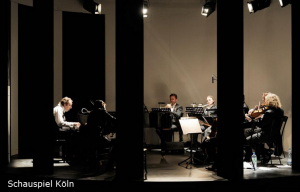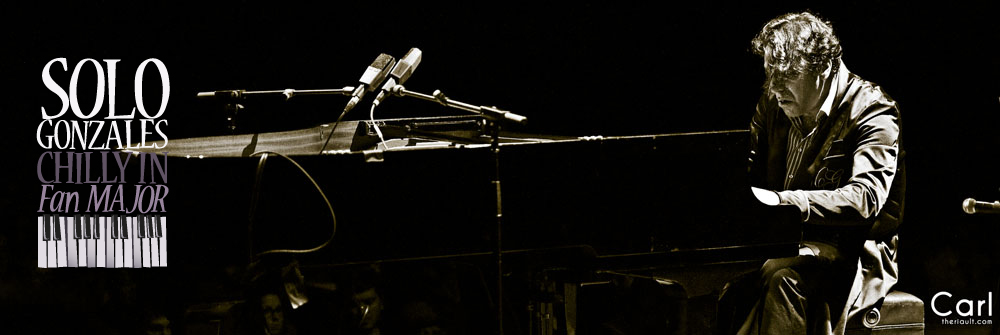 As the old story goes, was the word in the beginning. Then God created day and night, and divided the light from the darkness – or the light from the shadow. It is also the word, “logos”, that disturbs Faust in the famous study scene and it is a shadow, that has turned into a man, turning the proverb “a man, a word” into “a man, a shadow”. The Bible, Faust, Narcissus, Freud and many more influences emulsify in Hans Christian Andersen’s dark fairy tale “The Shadow” that Chilly Gonzales and his long-time friend and cohort Adam Traynor have brought on stage as an amalgamation of a live silent movie and a paper cut come alive. After the premiere at Hamburg’s Kampnagel, it is part of Schauspiel Köln’s repertoire until October.
As the old story goes, was the word in the beginning. Then God created day and night, and divided the light from the darkness – or the light from the shadow. It is also the word, “logos”, that disturbs Faust in the famous study scene and it is a shadow, that has turned into a man, turning the proverb “a man, a word” into “a man, a shadow”. The Bible, Faust, Narcissus, Freud and many more influences emulsify in Hans Christian Andersen’s dark fairy tale “The Shadow” that Chilly Gonzales and his long-time friend and cohort Adam Traynor have brought on stage as an amalgamation of a live silent movie and a paper cut come alive. After the premiere at Hamburg’s Kampnagel, it is part of Schauspiel Köln’s repertoire until October.
A monopteron, temple of the Muses and symbol for classicism and the ancient Greek conception of man, is the home of Chilly Gonzales and the Kaiser Quartet (plus an additional flute and horn player) for the duration of the play. White projection surfaces appear to the left and right, which either make the actors become black silhouettes or serve as a background for the rare intertitles, which are mostly dialogues. No words are being spoken, but the acting speaks for itself – or as Faust put it: “In the beginning was the deed”. Body language, exaggerated facial expressions, elements of dance, pantomime and slapstick replace the language and together with the music, the impact on the audience is even more intense than a verbal flood. The music is actually the play’s core. Chilly Gonzales’ composition ranges between Hitchcock, classical romantic exponents, Tom & Jerry, and the Love Boat theme song, and interacts straight with one’s center of emotions.
Much like Goethe’s Faust, Andersen’s protagonist is an idealistic scholar, whose work is dedicated “to the true, the beautiful, the good”. Goethe also used a similar phrase in his epilogue to Schiller’s “The Bell”, which at the same time is the title of another Andersen story. Living in an ivory tower (Gonzales and Traynor made a movie with the same name), he needs a deal with a dark spirit to overcome his own limitations and experience life in its fullest. In his case it’s not the devil disguised as a poodle, but his own shadow, that later not only becomes independent from his owner, but becomes (kind of) human. His transition is the result of the shadow discovering and experiencing “innermost nature” – the evil in man and sexuality – illustrated by explicit body movements and unleashed dancing resembling of the famous Faustian “Walpurgis Night”. On stage, the scholar’s shadow and later hangman (in the name of love) is in fact a woman, which makes way for various interpretations.
In the course of the story, the shadow succeeds in switching roles with his former owner and even more – gaining strength through his weakness. On its climax, they fight for a “princess”. The scene is set in a 1920s atmosphere of decadence and boredom. And it doesn’t come as a surprise that it’s a Gatsby-like deceit beating the scholar, when the shadow uses a camera to create an illusion of reality. In the manner of Gatsby’s famous quote “Can’t repeat the past? Why of course you can”, the shadow arises the old philosophical question what reality is after all and who defines it with modern means. He exposes our understanding of “the” reality as a doubtful and questionable concept. Additionally, the shadow uncovers through his “deeds”, how seduceable human nature is and what fuels the bad within: instinct, desire, hormones – the irrational side, or as Freud would put it, “id”.
In the end, The Shadow version of Gonzales and Traynor is more than an almost gothic fairy tale about duality, doppelganger, the dark side of the soul or the concept of a second identity. It is a mirror revealing not the beautiful self that Narcissus falls in love with, but the grim grimace we tend to suppress or even deny, as well as a reflection of human existence’s most vital questions – brought to you in an uncommon, entertaining and touching live performance that leaves you positively speechless.
